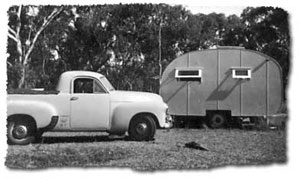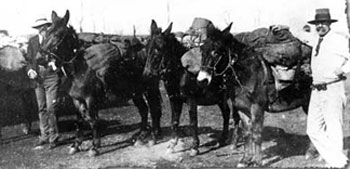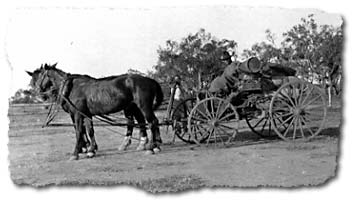Life of the surveyor in the field
Accommodation
With the extremes of climate (wet and dry) in Queensland, shelter was very important for the early surveyors. From the 1840s to the 1950s, the most common form of shelter was the tent. It was common for one tent to be allocated to the 'boss' at a suitable distance from the other men's tents. If a surveyor had his wife and family in camp, his tent and fittings became more elaborate.

The main camp would be set up on a water supply (e.g. waterhole, dam, bore) as close as possible to the survey being undertaken. The party would go out each day to survey the boundaries of the block.
When the distance from the main camp to the location of the survey became too far to walk or ride in a single day, a 'flying' camp would be established. Surveyors would sleep under a flimsy fly and take minimal provisions. They may have stayed in this temporary camp for as long as a week, after which they returned to the main camp. Surveyor EM Waraker, while surveying sugar selections beside the Johnstone River in 1882, was no stranger to flying camps:

‘All hands at Reardon's selection, long walk out and home, must camp out in the scrub next week, as the walking takes up half the time.’ (Waraker, EM 1882, Diary, John Oxley Library)
By the 1950s, with surveying in remote isolated areas becoming far less common, caravans became popular amongst government surveyors.
Food
Obtaining provisions from the land and squatters
The early Queensland surveyors were fortunate that many squatters had taken up their selections before the surveys were carried out. It was from these original settlers that the surveyors were able to purchase a limited supply of food, mainly meat, sugar, salt, flour and tea. However, not all stations were able to assist, as they received their supplies only once a year when roads were passable.
A lot of the early surveyors spent a considerable amount of time on continuous field surveys. At times this would take them away from their home base for periods of 12 months or more. While they carried certain provisions depending on the space available, supplements such as bush food became necessary. Surveyor CL Morell describes his diet in 1909 while working on the prickly pear surveys in south-western Queensland:
‘It was necessary, therefore, to purchase food supplies in bulk, and to restrict these to articles that would keep. This excludes fresh meat, green vegetables and fresh fruit. Our staple diet, therefore, consisted of salt beef, bread (and butter in winter), jam and other tinned items, rice, potatoes and onions. If a station homestead were handy, these could usually be replenished from station store, and fresh meat would, for one or two days, garnish the menu.’ (Morrell, CL 1909, Rambling about Queensland)

A diet of fresh wildlife
Duck, turkey, pigeon, kangaroo, possum, bandicoot, echidna, goanna, snake, hare, rabbit, fish, eels, yabbies and many other native food items formed part of the early surveyor's daily diet.

Surveyor EW Peachy, while surveying on the Darling Downs in 1859, described one of his meals:
‘... the dog caught a kangaroo rat and we cooked it and it was good as a hare, only it wanted flavour.’ (Peachey, EW 1859, Darling Downs Diary, MS6065, National Library of Australia)
Cadet surveyor Albert Hammermeister, while working in the Ravenswood area in 1924, wrote home to his mother describing the local bush food supply:
‘Talk about wild pigs and ducks. We went pig shooting and got enough pork to last for a month. It was great fun. We would ride on to a mob, pick out a nice young sow and chase her until she knocked up. The dogs used to bail them up, then we would shoot her and bleed her, and there you are, prime pork. The meat wasn’t rank at all. It was just as if they had been fed on milk and sweet potatoes. We didn't have a gun, worse luck, or we would have bagged a few ducks. Our cook that used to be, pawned the shot gun at a hotel for a few drinks. We have been going to get one ever since, but haven’t come to the point about it yet. We tried fishing last weekend (we are only four miles from the river here), but all we caught was three eels. It must have been the fish's off season.’ (Hammermeister, A 1924, Letters, Museum of Lands, Mapping and Surveying)

Provisions and the cook
One of the most important members of a survey party was the cook. CL Morell describes the attributes of one of his cooks:
‘Cooks, of course, were a class on their own, and were generally older men. A good cook was hard to find, and like a virtuous woman, his price was above rubies, although he was not paid quite on that basis. A bad cook can be costly. Each group of nomadic workers, whether surveyors, drovers, shearers, road or railway construction team, resembles a small army in one respect – it moves on its stomach, and bad cooking breeds grumbling. One cook engaged for my camp in Forbes, New South Wales, the only one offering, certainly had his limitations. He dished up boiled rice for every evening meal as a dessert, and then when pressed for a change, asked after hard consideration, “would they like some currents in their rice?”’ (Morrell, CL 1909, Rambling about Queensland)

Horses
Getting to the job and back home again was one of the most important functions the surveyor and his men had to perform. The colonial surveyor of the 1840s used horses for riding and oxen to pull the carts.
By the 1860s, horses alone acted as the prime movers of survey parties but donkeys and camels were often used in western areas.
Due to the paddocks being large, every survey party had a man that acted as the 'horse trailer'. His job was to care for the horses by putting them out at night and placing a bell on the neck of one horse. He would then round them up in the morning. He also did odd jobs around the camp.
Horses were often in short supply, especially in the government service. Surveyor RM Cochrane explained his problems caused by the lack of a suitable horse in a letter to the Surveyor General:

‘Sir, I have the honor to request that I may be allowed to procure a horse, saddle and bridle for use upon the Trig. Survey. I beg to remind you that I have to be at the various stations at 5.15am in order to get things ready for the early morning observations which commence at day break. For this purpose I have to leave my house at Lutwyche before 4am and walk into town four miles and then a further distance to the trig station then being occupied. This itself is a considerable distance, but owing to there being only one labourer, I have nearly everyday to walk many miles more placing staves in the various positions, resetting those displaced, or else I am working at the removal of the gear and the re-erection of the woodwork of the observatory. As we get further afield, the distances will be much increased and very shortly it will be physically impossible to walk to the work distances of six or seven miles and more by that early hour in the morning. As Mr Hoggan will testify, we are frequently on duty from ten to twelve hours per day, and I would respectfully submit that such long hours of work should not be prefaced by these exhausting walks. The one horse we have is known to be 22 years of age and has not sufficient strength to do one half the work required of it. Trusting this request will meet with your approval.’ (Cochrane, RM 1890, Trigonometrical letters, Museum of Lands, Mapping and Surveying)
Boats
In the jungles of north Queensland, surveyors often used boats to get to their job. However, due to the nature of the northern rivers difficulties were often encountered. This was experienced by Surveyor EM Waraker while surveying sugar selections near the Johnstone River in 1882:
‘Difficulty in getting boat up the rapids, all of us wading in the water and hauling boat after us, pretty jolly day altogether.’ (Waraker, EM 1882, Diary, John Oxley Library)

Motor vehicles
By the 1920s, surveyors were converting to the motor vehicle to get to the survey camp and beyond. They required petrol, but were not dependant on nature's water and grass.
After World War II, the Army presence gave surveyors access to four wheel drive vehicles. This gave them the ability to penetrate remote locations.
Past problems of accessing survey camps and sites in difficult locations have been overcome by the use of helicopters. This allows surveyors access into the most rugged and formidable areas.
Related links
- Learn about Queensland’s historical surveying processes.
- View images of instruments and equipment used to survey and map Queensland.


